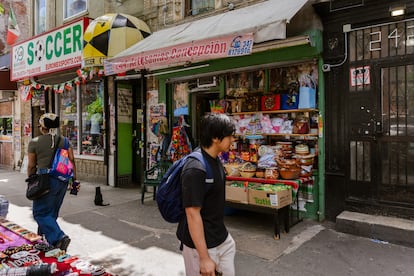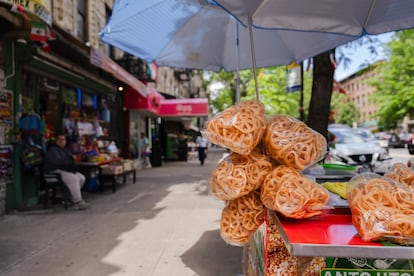Mexicans make up the third largest Hispanic population in New York City, surpassed only by Puerto Ricans and Dominicans. According to the latest US census data, 514,000 Mexicans live in the Big Apple—and approximately 1.5 million in New York State. If you want to delve into popular Mexican food, close your eyes and teleport for a few minutes to the country of tequila and cactus, you can do it in East Harlem. There is what is known as Little Mexico, a New York neighborhood with a Mexican soul, which was formed in the nineties and grew until it was consolidated. It is not yet a tourist attraction on the scale of Little Italy in the Bronx or the two Chinatowns—in Manhattan and Queens—but its function is more valuable: it offers immigrants the experience of feeling at home. Some 50,000 Mexicans have already made their home there.
One of the first Mexican businessmen to open a business in the neighborhood is Jaime Flores, owner of Euromex, a store where you can get soccer kits for both Latin and European teams, and who also owns the Azteca Unisex barbershop. Flores opened his first business back in 1994, when he was less than twenty years old and had just arrived from Mexico. “Immigrants made me grow up, but now I also have clients born here and they buy from me in other states like California, Chicago or Texas.” As he remembers, it was a visit by former Mexican president Vicente Fox that began to make the neighborhood famous, which has already begun to gentrify. “Many Latinos have had to emigrate to the Bronx because the price of rent has doubled,” he says. But his business is still in the same location after thirty years and he feels that he has succeeded. He works seven days a week because he has clients daily and he is proud to say that he has been able to send his three children to college: “New York has treated me well, but I have worked hard.”
The Mexican is an entrepreneurial community in New York: 18% own their own business, many related to restaurants. The boom responds to, and is responsible for, the boost in Mexican gastronomy in the city in recent years. Already in 2020, there were almost a thousand Mexican restaurants with a high-quality offering in any of the five districts of the city. There are 20 of them recognized in the Michelin guide. Among the most notable are Casa Enrique, the first Mexican restaurant in New York to receive a Michelin star; Oxomoco, the only one that currently has a star; and Cosme, which three years ago was ranked 22nd of the 50 best restaurants in the world.
But you can’t visit the neighborhood without making a stop at Hot Jalapeño, Quesadillas Doña Maty or the Tacomix taqueria, whose manager, Marlene Ruiz, explains that although “the clientele is mainly Latin, during the weekends or when there are events in Roosevelt Island (the neighboring island, where music festivals like The Governors Ball are held) the restaurant is filled with white people.”
The famous street food, the most authentic smells and sounds are concentrated in this corner of northern Manhattan. It is no coincidence that Little Mexico has flourished there. Historically, East Harlem is called Spanish Harlem because it concentrates a good part of New York’s Hispanic population since a first wave of Puerto Ricans settled there after World War II.

The Museo del Barrio is located there, the most important of Latin American art in the country. And from that façade facing Central Park, Little Mexico extends, encompassing the entire east, so that from 96th to 125th Street you can feel the Latin spirit in the color of the streets, in murals such as The Spirit of East Harlem or the Graffiti Hall of Fame, in community centers or in music that escapes from establishments without asking permission.
Little Tenochtitlán, as it is also called, has its center on 116th Street, cutting off Second and Third Avenues, where it is common to find street vendors of horchata, tamales and elotes. There are taquerias, bakeries and wineries where you can buy fresh ingredients, from tortillas or moles to nopales and all kinds of chilies and hot sauces. But it’s not all food. If you need a haircut, the hair salon, like almost all the businesses on these streets, is also run by Mexicans. If you are looking to renew your wardrobe, you can buy clothes with prints of the Virgin of Guadalupe, traditional costumes and even a shirt from the Mexican soccer league. There are stores with traditional brands where you can find everything that is sold in Mexico: from cleaning products to sweets, crafts, amulets or religious figures to the classic birthday piñatas.

St. Paul’s Church, also in the area, is frequented primarily by the Latino community, with masses and catechism classes in Spanish. And every year, for the quintessential festival of Mexican-Ame
rican cultural syncretism, on May 5, the streets become even more colorful and the street food stalls multiply to accompany the parade that begins at noon in Central Park West to the rhythm of mariachis.
Although there is also a large Mexican population in neighborhoods like Sunset Boulevard or Jackson Heights, today Little Mexico is undoubtedly the place to soak up Mexico in New York. The first American metropolis thus follows in the footsteps of other large cities in the country such as Los Angeles, Chicago, Houston or San Francisco, which offer Mexicans the joy and warmth of their homeland, a piece of their own in a foreign country.

#Manhattan #Chinatown #Koreatown #Italy.. #Mexico

